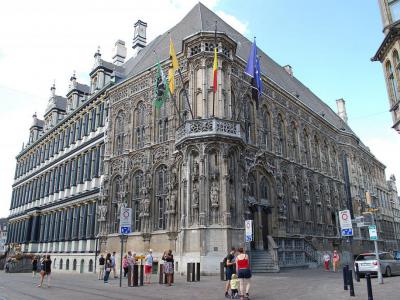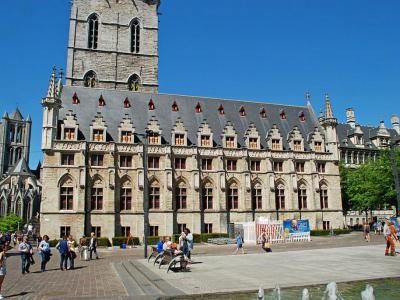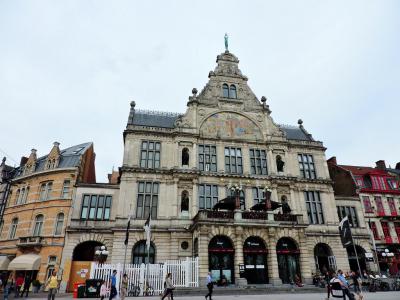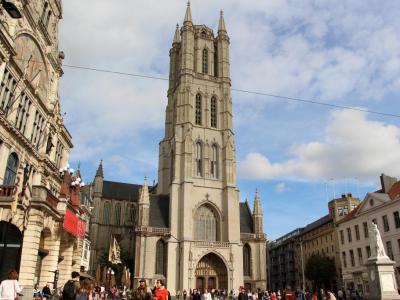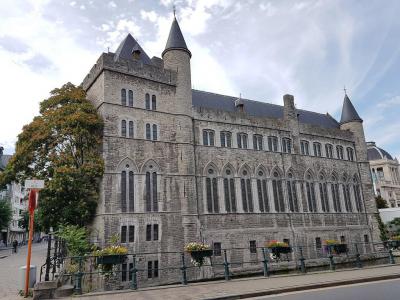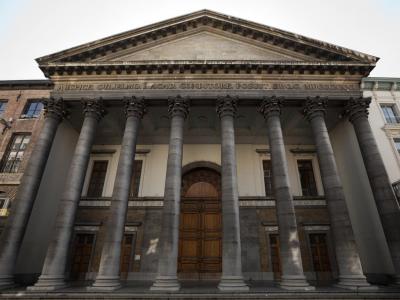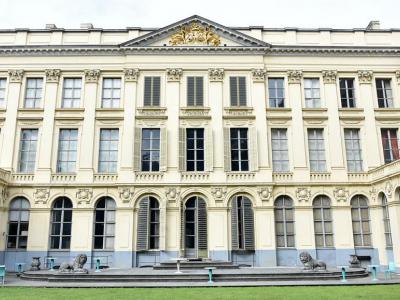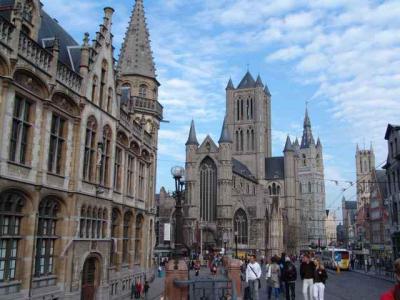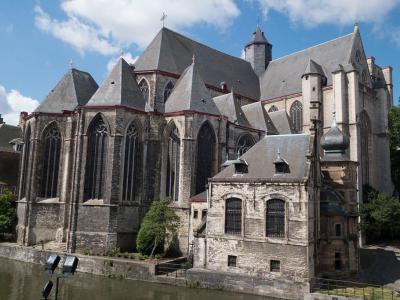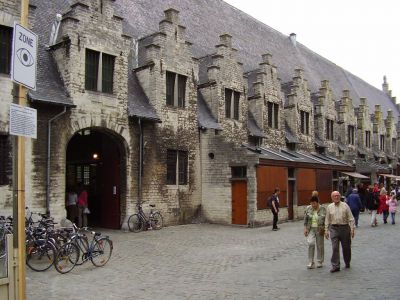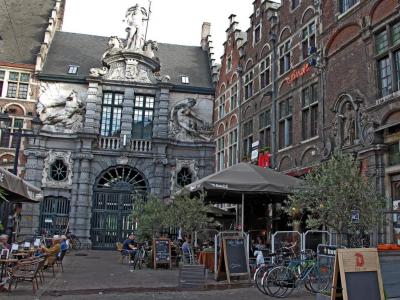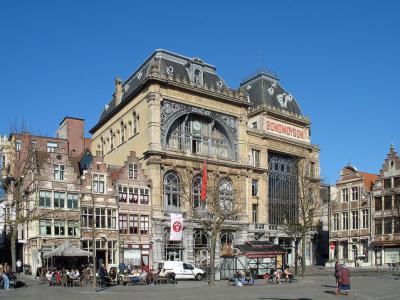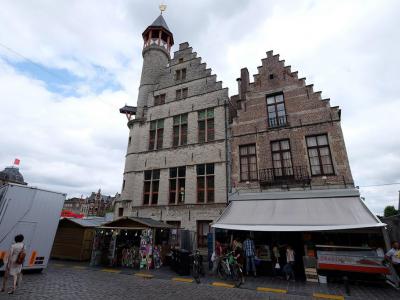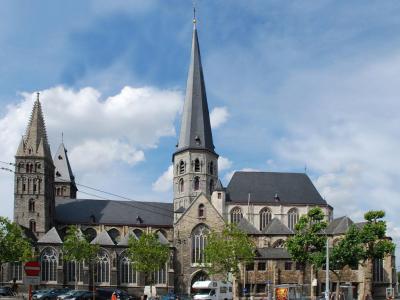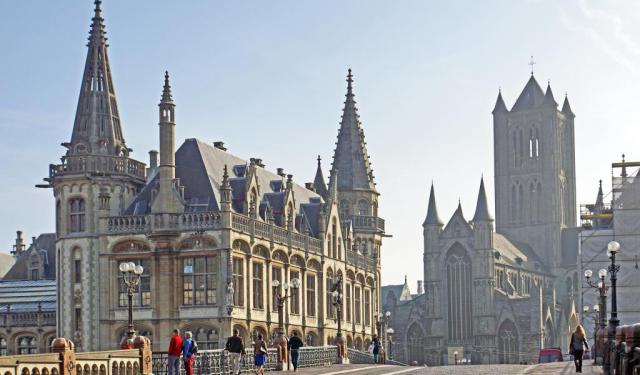
Ghent's Historical Buildings (Self Guided), Ghent
The medieval city of Ghent is full of wonderful old buildings, some dating back as far as the 12th-13th centuries. Medieval buildings are indeed everywhere here, and if you're interested in the heritage fit to capture you imagination, you will find plenty of it in Ghent’s historic downtown.
And you won’t have to look far for the World Heritage worthy of its name either. The Castle of Gerald the Devil is just a stone's throw away from the imposing St Bavo’s Cathedral, much as from other architectural gems like Lakenhalle and the Royal Dutch Theater. Also, the inner city boasts a multitude of ancient churches, such as Sint-Niklaaskerk, Sint-Michielskerk and Sint-Jacobskerk, not to mention a host of prominent commercial buildings like Groot Vleeshuis, Oude Vismijn, and Bond Moyson. A truly spectacular amount of history per square mile!
All these buildings contribute a great deal to Ghent's fairy tale cityscape, especially those set along the canal and in the squares.
Without a doubt, you can see multiple landmarks of Ghent on a self-guided tour of the city, especially if loaded with GPSmyCity app on your mobile device. To experience the convenience thereof first hand, take this walk and see for yourself!
And you won’t have to look far for the World Heritage worthy of its name either. The Castle of Gerald the Devil is just a stone's throw away from the imposing St Bavo’s Cathedral, much as from other architectural gems like Lakenhalle and the Royal Dutch Theater. Also, the inner city boasts a multitude of ancient churches, such as Sint-Niklaaskerk, Sint-Michielskerk and Sint-Jacobskerk, not to mention a host of prominent commercial buildings like Groot Vleeshuis, Oude Vismijn, and Bond Moyson. A truly spectacular amount of history per square mile!
All these buildings contribute a great deal to Ghent's fairy tale cityscape, especially those set along the canal and in the squares.
Without a doubt, you can see multiple landmarks of Ghent on a self-guided tour of the city, especially if loaded with GPSmyCity app on your mobile device. To experience the convenience thereof first hand, take this walk and see for yourself!
How it works: Download the app "GPSmyCity: Walks in 1K+ Cities" from Apple App Store or Google Play Store to your mobile phone or tablet. The app turns your mobile device into a personal tour guide and its built-in GPS navigation functions guide you from one tour stop to next. The app works offline, so no data plan is needed when traveling abroad.
Ghent's Historical Buildings Map
Guide Name: Ghent's Historical Buildings
Guide Location: Belgium » Ghent (See other walking tours in Ghent)
Guide Type: Self-guided Walking Tour (Sightseeing)
# of Attractions: 14
Tour Duration: 2 Hour(s)
Travel Distance: 2.8 Km or 1.7 Miles
Author: vickyc
Sight(s) Featured in This Guide:
Guide Location: Belgium » Ghent (See other walking tours in Ghent)
Guide Type: Self-guided Walking Tour (Sightseeing)
# of Attractions: 14
Tour Duration: 2 Hour(s)
Travel Distance: 2.8 Km or 1.7 Miles
Author: vickyc
Sight(s) Featured in This Guide:
- Stadhuis (Town Hall)
- Lakenhalle (Cloth Hall)
- Koninklijke Nederlandse Schouwburg (Royal Dutch Theater)
- Sint-Baafskathedraal (St Bavo's Cathedral)
- Geeraard de Duivelsteen (Castle of Gerald the Devil)
- Aula Academica of Ghent University
- Hotel d'Hane-Steenhuyse
- Sint-Niklaaskerk (St. Nicholas Church)
- Sint-Michielskerk (Saint Michael's Church)
- Groot Vleeshuis (Great Butcher's Hall)
- Oude Vismijn (Old Fish Market)
- Bond Moyson Building
- Toreken (The Tower)
- St-Jacobskerk (St James' Church)
1) Stadhuis (Town Hall) (must see)
The Town Hall of Ghent is a quadrangular group of buildings of different styles. The alderman's house of Keure is in the Flamboyant Gothic style (1519-1539). It was designed by Rombout Keldermans and Dominicus de Waeghenmackere. Niches in the facade hold 19 statues of the Counts of Flanders made in the 19th and 20th centuries.
The Gedele Alderman's house is Renaissance, built between 1595n and 1618. The facades of both Alderman's houses hold Doric, Ionic and Corinthian three-quarter columns and pilasters. The effect is reminiscent of Italian palace. The complex is surrounded by the streets of Patermarkt, Hoogspoort, Stadhuistaaeg and Pooljiemarkt.
Inside the town hall are 51 rooms, including a wedding chapel and a labyrinth. The most important halls in the town hall are the Pacification Hall, the Arsenal hall, the Cabinet of the Mayor (1728), the Throne Room and the Reception lounge, formerly the chamber of the States of Flanders.
The interior rooms vary greatly in style but all are lavishly decorated. Weddings in the Halle are in demand but tourist access is limited.
Tip:
You can get a tour by booking with a guide at the information center. Well worth the money – lots of interesting history. If the weather is nice, have a drink outside one of the bars opposite and take your time to enjoy the facade.
The Gedele Alderman's house is Renaissance, built between 1595n and 1618. The facades of both Alderman's houses hold Doric, Ionic and Corinthian three-quarter columns and pilasters. The effect is reminiscent of Italian palace. The complex is surrounded by the streets of Patermarkt, Hoogspoort, Stadhuistaaeg and Pooljiemarkt.
Inside the town hall are 51 rooms, including a wedding chapel and a labyrinth. The most important halls in the town hall are the Pacification Hall, the Arsenal hall, the Cabinet of the Mayor (1728), the Throne Room and the Reception lounge, formerly the chamber of the States of Flanders.
The interior rooms vary greatly in style but all are lavishly decorated. Weddings in the Halle are in demand but tourist access is limited.
Tip:
You can get a tour by booking with a guide at the information center. Well worth the money – lots of interesting history. If the weather is nice, have a drink outside one of the bars opposite and take your time to enjoy the facade.
2) Lakenhalle (Cloth Hall) (must see)
The Lakenhalle, or Cloth Hall, is adjunct to the Belfry. Construction started in 1425 but it was still incomplete twenty years later. Only seven of the eleven bays had been completed. In 1903 four more bays were added.
The Cloth Hall was built to harbor the business of the cloth trade of Ghent. Woolens and textiles had made Ghent a boom town of the middle ages. Fortune changes. The textile trades fell off in time and other tenants, including a militia Guild and a fencing school, moved into the Cloth Hall.
There is an annex to the Cloth Hall dating from 1741, called the "Mammelokker." The annex was the guards' quarters and the entrance to the city jail in the Cloth Hall from 1742 until 1902. The name Mammelokker means "breast sucker." It refers to the sculpture of the Roman legend of Pero and Cimon above the front door of the annex.
Cimon was sentenced to death by starvation. His daughter, Pero, who was a wet nurse, visited him in prison and breastfed him. She saved his life. His guards, awed by this show of filial devotion, released him.
Tip:
Visiting the Cloth Hall is free; the belfry, however, is not.
The Cloth Hall was built to harbor the business of the cloth trade of Ghent. Woolens and textiles had made Ghent a boom town of the middle ages. Fortune changes. The textile trades fell off in time and other tenants, including a militia Guild and a fencing school, moved into the Cloth Hall.
There is an annex to the Cloth Hall dating from 1741, called the "Mammelokker." The annex was the guards' quarters and the entrance to the city jail in the Cloth Hall from 1742 until 1902. The name Mammelokker means "breast sucker." It refers to the sculpture of the Roman legend of Pero and Cimon above the front door of the annex.
Cimon was sentenced to death by starvation. His daughter, Pero, who was a wet nurse, visited him in prison and breastfed him. She saved his life. His guards, awed by this show of filial devotion, released him.
Tip:
Visiting the Cloth Hall is free; the belfry, however, is not.
3) Koninklijke Nederlandse Schouwburg (Royal Dutch Theater)
Situated on the north side of Sint-Baafsplein Square, between St. Bavo's Cathedral and the Belfry Tower, is a great historic building – The Royal Dutch Theater. Designed by architect Edmond De Vigne, it features a rather eclectic style, dominated by neo-Renaissance features.
Although the façade says “ANNO 1897”, the building was actually inaugurated only in 1899. The façade consists of three storeys of five bays. The central section of three bays is strongly accentuated and is flanked in the second and third storeys by four statues of men in 17th-century costume, made by Louis Mast. They represent the four chambers of rhetoric in Ghent: De Fonteine, Sint-Barbara, Sint-Agnete, and Maria ter Ere.
The central part of the façade is crowned by a monumental gable; the mosaic – nine meters wide and four meters high – incorporated into a round-arched tympanum, consisting of 70,000 ceramic stones in 500 different colors, was created by Constant Montald. It features a mythological scene depicting the god Apollo in his sun chariot, accompanied by nine muses, recognizable by their respective attributes.
At the very top of the building, majestically looking out over the square, is a bronze statue of a woman with a lyre – Lady Harmonia, the Genius of Music. This was designed by the Ghent sculptor, Aloys Buyens.
The building has been protected as a monument since 1986. It was completely renovated between 1987 and 1993 whilst adapted to the modern requirements of theater technology and fire safety.
Visitors are allowed inside the theater only during performances; however, the foyer on the first floor is open to all. You can purchase tickets in the entrance hall on the ground floor. If you happen to catch a play here, make sure also to go to the terrace for some nice views of Sint-Baafsplein.
Although the façade says “ANNO 1897”, the building was actually inaugurated only in 1899. The façade consists of three storeys of five bays. The central section of three bays is strongly accentuated and is flanked in the second and third storeys by four statues of men in 17th-century costume, made by Louis Mast. They represent the four chambers of rhetoric in Ghent: De Fonteine, Sint-Barbara, Sint-Agnete, and Maria ter Ere.
The central part of the façade is crowned by a monumental gable; the mosaic – nine meters wide and four meters high – incorporated into a round-arched tympanum, consisting of 70,000 ceramic stones in 500 different colors, was created by Constant Montald. It features a mythological scene depicting the god Apollo in his sun chariot, accompanied by nine muses, recognizable by their respective attributes.
At the very top of the building, majestically looking out over the square, is a bronze statue of a woman with a lyre – Lady Harmonia, the Genius of Music. This was designed by the Ghent sculptor, Aloys Buyens.
The building has been protected as a monument since 1986. It was completely renovated between 1987 and 1993 whilst adapted to the modern requirements of theater technology and fire safety.
Visitors are allowed inside the theater only during performances; however, the foyer on the first floor is open to all. You can purchase tickets in the entrance hall on the ground floor. If you happen to catch a play here, make sure also to go to the terrace for some nice views of Sint-Baafsplein.
Sight description based on Wikipedia.
4) Sint-Baafskathedraal (St Bavo's Cathedral) (must see)
In 1566 the Calvanist iconoclasts were on a rampage in the Netherlands. Raiding churches, they found a target rich environment. Stained glass windows, statues, artwork, everything had to go. Three days before they got to St. Bavo's, artwork was hidden in the crypt and St. Bavo's was mostly spared.
St. Bavo's Cathedral or Saint-Baafskathedraal, is a 292 foot tall Catholic cathedral in Ghent. It is built on the site of the wooden Chapel of Saint John the Baptist, founded in 942 by Transmanus, Bishop of Tournai and Noyon. Construction of a new Romanesque church began there in 1150.
In the 14th through the 16th centuries ambitious Gothic renovations were added. On top of the lower Romanesque church a high Gothic choir and an enormous vault with tall windows was built. Around the choir is an ambulatory and 14 chapels. The 292 foot tower was erected in 1534. The church became a cathedral in 1569. A new nave was added by 1590.
Among the treasures that were saved from the iconoclasts of 1566 is the Famous Ghent Altarpiece, a painted polyptych by the van Eyck brothers Jan and Hubert in 1432.
Other artists represented in the cathedral are Peter Paul Rubens and Lucas de Heere. Frans Pourbus the Elder created 14 panels of The History of Saint Andrew (1572). There are three paintings by Caspar de Crayer, including The Beheading of John the Baptist. Eleven grisailles of the Old and New Testaments adorn the choir above the stalls.
The high choir is an awesome part of the interior. It has stalls for members of the Chapter of Saint-Bavon. The Baroque High Altar, installed from 1702 to 1782, is made with black, white and red flamed marble. In the nave is a rococo pulpit from 1745.
In the crypt are reliquaries and collections of liturgical ornaments and vessels. Virtual tours of the crypt, including the altarpiece, are available. There is a basic tour and an advanced tour of at least ninety minutes. Do not miss the painting of the Mystic Lamb.
St. Bavo's Cathedral or Saint-Baafskathedraal, is a 292 foot tall Catholic cathedral in Ghent. It is built on the site of the wooden Chapel of Saint John the Baptist, founded in 942 by Transmanus, Bishop of Tournai and Noyon. Construction of a new Romanesque church began there in 1150.
In the 14th through the 16th centuries ambitious Gothic renovations were added. On top of the lower Romanesque church a high Gothic choir and an enormous vault with tall windows was built. Around the choir is an ambulatory and 14 chapels. The 292 foot tower was erected in 1534. The church became a cathedral in 1569. A new nave was added by 1590.
Among the treasures that were saved from the iconoclasts of 1566 is the Famous Ghent Altarpiece, a painted polyptych by the van Eyck brothers Jan and Hubert in 1432.
Other artists represented in the cathedral are Peter Paul Rubens and Lucas de Heere. Frans Pourbus the Elder created 14 panels of The History of Saint Andrew (1572). There are three paintings by Caspar de Crayer, including The Beheading of John the Baptist. Eleven grisailles of the Old and New Testaments adorn the choir above the stalls.
The high choir is an awesome part of the interior. It has stalls for members of the Chapter of Saint-Bavon. The Baroque High Altar, installed from 1702 to 1782, is made with black, white and red flamed marble. In the nave is a rococo pulpit from 1745.
In the crypt are reliquaries and collections of liturgical ornaments and vessels. Virtual tours of the crypt, including the altarpiece, are available. There is a basic tour and an advanced tour of at least ninety minutes. Do not miss the painting of the Mystic Lamb.
5) Geeraard de Duivelsteen (Castle of Gerald the Devil)
The Geeraard de Duivelsteen ("The Castle of Geeraard the Devil") is a Medieval fortress that once served to defend the Portus aan de Reep, a trading settlement from where the city of Ghent had originated. This is evident from the very thick walls, the presence of turrets and a reduit for monitoring and defending the area in case of an attack.
Despite the name and grim appearance, no devil has ever lived here. The Gothic-style edifice with the elements of Romanesque was built in the 13th century and was named after the knight Geeraard Vilain (1210-1270), the son of the 15th Viscount of Ghent, Zeger III, who used to live here. Vilain's nickname, "Geeraard de Duivel" ("Geerard the Devil"), was due to his dark hair and complexion.
Until the first half of the 14th century the castle had remained residence of Geeraard's descendants, after which it became a municipal property. Over the years that followed, the building had served a variety of functions: a gathering place for noblemen, an arsenal, a monastery, a school, an episcopal seminary, and a prison.
In 1807, the fortress was used as an orphanage for boys, and then from 1815 as an asylum for the mentally ill. In 1830, the Geeraard de Duivelsteen became a fire station. Towards the end of the 19th century it was bought by the Belgian government to house a national archive, for which purpose a new wing was added. The castle served in this capacity until 2015.
Presently, there are plans for the building to be converted into a luxury bloc of flats and a youth center.
Despite the name and grim appearance, no devil has ever lived here. The Gothic-style edifice with the elements of Romanesque was built in the 13th century and was named after the knight Geeraard Vilain (1210-1270), the son of the 15th Viscount of Ghent, Zeger III, who used to live here. Vilain's nickname, "Geeraard de Duivel" ("Geerard the Devil"), was due to his dark hair and complexion.
Until the first half of the 14th century the castle had remained residence of Geeraard's descendants, after which it became a municipal property. Over the years that followed, the building had served a variety of functions: a gathering place for noblemen, an arsenal, a monastery, a school, an episcopal seminary, and a prison.
In 1807, the fortress was used as an orphanage for boys, and then from 1815 as an asylum for the mentally ill. In 1830, the Geeraard de Duivelsteen became a fire station. Towards the end of the 19th century it was bought by the Belgian government to house a national archive, for which purpose a new wing was added. The castle served in this capacity until 2015.
Presently, there are plans for the building to be converted into a luxury bloc of flats and a youth center.
Sight description based on Wikipedia.
6) Aula Academica of Ghent University
The Aula Academica (Assembly Hall) is an iconic place at Ghent University. Not long after the establishment of the University in 1817 it was decided that the new institution needed a flagship auditorium. On August 4, 1819, the foundation stone of the Aula Academica was solemnly laid in the name of King Willem I on the site of the former Jesuit church in Voldersstraat.
The imposing Hall was inaugurated on October 3, 1826. Over the following years it had played an important role in the history of both the Netherlands and Belgium, as well as the Flemish Movement.
The Neo-Classical masterpiece created by the young Ghent architect, Lodewijk Roelandt, marked the outset of his great career. The façade was inspired by the pantheon in Rome, with a prostylon of eight Corinthian columns, topped by a pediment. The eight columns came from the former infirmary of St. Peter's Abbey. The frieze with a Latin inscription recalls William I's building assignment. Inside, the Hall culminates in the Academy Council Chamber.
During WWI the building was actively involved in the Dutchification of the University of Ghent, as well as in propaganda of Dutch culture in Belgium. In 1988, the Aula literally became the University symbol, with the old coat of arms on the façade replaced with the image of goddess Minerva.
In addition to its function as a temple of learning, attesting to which is a gigantic statue of Minerva, throughout its history the Aula has hosted many other events, such as emeritus ceremonies, symposiums, anniversaries, commemorations and conferences, as well as numerous exhibitions not always related to the University itself.
Each academic year is opened at the Aula with a proclamation. In 1995 the building was declared a protected monument.
The imposing Hall was inaugurated on October 3, 1826. Over the following years it had played an important role in the history of both the Netherlands and Belgium, as well as the Flemish Movement.
The Neo-Classical masterpiece created by the young Ghent architect, Lodewijk Roelandt, marked the outset of his great career. The façade was inspired by the pantheon in Rome, with a prostylon of eight Corinthian columns, topped by a pediment. The eight columns came from the former infirmary of St. Peter's Abbey. The frieze with a Latin inscription recalls William I's building assignment. Inside, the Hall culminates in the Academy Council Chamber.
During WWI the building was actively involved in the Dutchification of the University of Ghent, as well as in propaganda of Dutch culture in Belgium. In 1988, the Aula literally became the University symbol, with the old coat of arms on the façade replaced with the image of goddess Minerva.
In addition to its function as a temple of learning, attesting to which is a gigantic statue of Minerva, throughout its history the Aula has hosted many other events, such as emeritus ceremonies, symposiums, anniversaries, commemorations and conferences, as well as numerous exhibitions not always related to the University itself.
Each academic year is opened at the Aula with a proclamation. In 1995 the building was declared a protected monument.
Sight description based on Wikipedia.
7) Hotel d'Hane-Steenhuyse
The Hotel d'Hane-Steenhuyse is an 18th-century city palace. It was a possession of the D'Hane de Steenhuyse family for a while.
The building was erected in 1768–1773 by Jan Baptist Simoens, who designed and built the rear facade and the salle à l'italienne with certainty. The facade was perhaps designed by David 't Kindt, but archival evidence is not of this. Around the beginning of the 19th century, the building was used for the noble society, culminating in the stay in 1815 of King Louis XVIII expelled from France. With his court he ruled from the hotel in exile. Afterward, he gave his host, as a thank you, a porcelain dessert service that is now kept in the STAM.
In the twentieth century the hotel fell into disuse. The Museum of the Hundred Days was accommodated there in 1949, but without much success.
In 1981, the building became the property of the city of Ghent, which first included an information center and later the Monuments Management Service. In the 1990s it underwent a thorough renovation. Public access was, however, very limited. In 2015, the ground floor was opened for commercial activities.
The building was erected in 1768–1773 by Jan Baptist Simoens, who designed and built the rear facade and the salle à l'italienne with certainty. The facade was perhaps designed by David 't Kindt, but archival evidence is not of this. Around the beginning of the 19th century, the building was used for the noble society, culminating in the stay in 1815 of King Louis XVIII expelled from France. With his court he ruled from the hotel in exile. Afterward, he gave his host, as a thank you, a porcelain dessert service that is now kept in the STAM.
In the twentieth century the hotel fell into disuse. The Museum of the Hundred Days was accommodated there in 1949, but without much success.
In 1981, the building became the property of the city of Ghent, which first included an information center and later the Monuments Management Service. In the 1990s it underwent a thorough renovation. Public access was, however, very limited. In 2015, the ground floor was opened for commercial activities.
Sight description based on Wikipedia.
8) Sint-Niklaaskerk (St. Nicholas Church) (must see)
St Nicholas Church is one of the celebrated "Three Towers of Ghent." Building was begun in the 13th century to replace an earlier Romanesque structure. The style of construction is Scheldt Gothic. This style called for the use of blue-gray stone taken from the area of Tournai. There is a single tower above the crossing and corner turrets.
The church has had a stormy existence. During the 16th century militant iconoclasts destroyed its religious images and artifacts. Come the French revolution, the church served as a stable for horses. By the 1700s numerous shops and small houses had been built clinging to the church's outer walls.
Extensive restoration carried out in the 19th century has rescued the church from a dilapidated ending. The Scheldt Gothic style tower is above the nave and transepts instead of the main entrance. As a result, light from the tower is permitted to illuminate the transept.
The organ of the church is one of the most impressive in the country. It was built by the famous French organ maker, Aristide Canaille-Coll. The instrument is a three-manual organ with 16 pipes in front. The inauguration concert was given by Louis James Lefebure-Wely in 1856.
The church is open every day. Admission is free.
The church has had a stormy existence. During the 16th century militant iconoclasts destroyed its religious images and artifacts. Come the French revolution, the church served as a stable for horses. By the 1700s numerous shops and small houses had been built clinging to the church's outer walls.
Extensive restoration carried out in the 19th century has rescued the church from a dilapidated ending. The Scheldt Gothic style tower is above the nave and transepts instead of the main entrance. As a result, light from the tower is permitted to illuminate the transept.
The organ of the church is one of the most impressive in the country. It was built by the famous French organ maker, Aristide Canaille-Coll. The instrument is a three-manual organ with 16 pipes in front. The inauguration concert was given by Louis James Lefebure-Wely in 1856.
The church is open every day. Admission is free.
9) Sint-Michielskerk (Saint Michael's Church)
Sint-Michielskerk (Saint Michael's Church) is a Roman Catholic temple in Ghent. Documents attesting to the existence of a chapel dedicated to St. Michael on this site date from 1105. That building was twice destroyed by fire in the 12th century and rebuilt.
Construction of the current, late-Gothic church was commenced circa 1440, and was done in two phases, separated by a long interval. During the first phase, in the 15th-16th centuries, the western part, including three-aisled nave and the transept, was completed by 1528. Construction of the western tower continued and by 1566 two levels of it had been finished. Then, due to religious conflicts, the construction had stopped and looting and destruction followed. Part of the church was destroyed in 1578 by Calvinists and in 1579 the old choir was demolished.
It wasn't until 1623 that the church's construction resumed. The Baroque style sacristy in the north-east was built in 1650-1651. Local architect Lieven Cruyl made a design for the unfinished western tower in 1662, which again wasn't materialized for a number of reasons. The tower was finally covered with a flat roof only in 1828.
The church has a rich Neo-Gothic interior, including an altar and a pulpit. Inside there are various 18th century statues, plus a number of Baroque paintings, including “Christ Dying on the Cross” by Anthony van Dyck, “Resurrection of Lazarus” by Otto Venius, and many others.
There is also a collection of silver and gold artifacts. Among them are the relic of St Dorothea in silver; the sacred "Doorn" donated by Mary, Queen of Scots; and the true Cross – a gift from the Archduke Albrecht and Isabella made in 1619.
Construction of the current, late-Gothic church was commenced circa 1440, and was done in two phases, separated by a long interval. During the first phase, in the 15th-16th centuries, the western part, including three-aisled nave and the transept, was completed by 1528. Construction of the western tower continued and by 1566 two levels of it had been finished. Then, due to religious conflicts, the construction had stopped and looting and destruction followed. Part of the church was destroyed in 1578 by Calvinists and in 1579 the old choir was demolished.
It wasn't until 1623 that the church's construction resumed. The Baroque style sacristy in the north-east was built in 1650-1651. Local architect Lieven Cruyl made a design for the unfinished western tower in 1662, which again wasn't materialized for a number of reasons. The tower was finally covered with a flat roof only in 1828.
The church has a rich Neo-Gothic interior, including an altar and a pulpit. Inside there are various 18th century statues, plus a number of Baroque paintings, including “Christ Dying on the Cross” by Anthony van Dyck, “Resurrection of Lazarus” by Otto Venius, and many others.
There is also a collection of silver and gold artifacts. Among them are the relic of St Dorothea in silver; the sacred "Doorn" donated by Mary, Queen of Scots; and the true Cross – a gift from the Archduke Albrecht and Isabella made in 1619.
Sight description based on Wikipedia.
10) Groot Vleeshuis (Great Butcher's Hall)
The Groot Vleeshuis (Great Butcher's Hall) is a former covered market and guildhall. Back in the late Middle Ages, there was another Groot Vleeshuis in Ghent, on the Vismarkt (now Groentenmarkt). The first mention of it in the city documents appears in 1332-1333.
The old butcher's house, made of wood, was much smaller than the current building. Around 1407 it grew increasingly dilapidated and the butchers left it for a new, larger one. Between 1446 and 1448, a chapel with a meeting room was built in the southwestern corner. Also, to ensure a steady supply of fish, four canals had been made underneath the building to enable flat fishing boats to reach the Vismarkt directly from the Lys River. The vaults of these passages are still seen on the side of the river.
In 1543, 16 tripe houses (shops) were added, in which viscera, intestinal fat and other remains of slaughtered animals, in addition to poultry, were sold – previously not allowed inside the Hall. By the end of the 19th century, the Groot Vleeshuis became vacant following the construction of a new meat house next to the Vismijn on Sint-Veerleplein.
In the run-up to the 1913 World's Fair, a decision was taken to restore the Groot Vleeshuis along with the tripe houses to their pre-1744 condition. The renewed Hall, designed by architect Van Hamme, received additional uses as a market for fruit and vegetables, the Post and Telegraph office, a parking garage and a partial fish trade.
The unique building, protected as a monument since 1943, underwent overhaul in the late 1990s. Today it houses a promotion center for East Flemish regional products. Here you will find many Belgian specialties, like chocolates, beer and other tasty delights, not to mention a variety of local souvenirs.
The old butcher's house, made of wood, was much smaller than the current building. Around 1407 it grew increasingly dilapidated and the butchers left it for a new, larger one. Between 1446 and 1448, a chapel with a meeting room was built in the southwestern corner. Also, to ensure a steady supply of fish, four canals had been made underneath the building to enable flat fishing boats to reach the Vismarkt directly from the Lys River. The vaults of these passages are still seen on the side of the river.
In 1543, 16 tripe houses (shops) were added, in which viscera, intestinal fat and other remains of slaughtered animals, in addition to poultry, were sold – previously not allowed inside the Hall. By the end of the 19th century, the Groot Vleeshuis became vacant following the construction of a new meat house next to the Vismijn on Sint-Veerleplein.
In the run-up to the 1913 World's Fair, a decision was taken to restore the Groot Vleeshuis along with the tripe houses to their pre-1744 condition. The renewed Hall, designed by architect Van Hamme, received additional uses as a market for fruit and vegetables, the Post and Telegraph office, a parking garage and a partial fish trade.
The unique building, protected as a monument since 1943, underwent overhaul in the late 1990s. Today it houses a promotion center for East Flemish regional products. Here you will find many Belgian specialties, like chocolates, beer and other tasty delights, not to mention a variety of local souvenirs.
Sight description based on Wikipedia.
11) Oude Vismijn (Old Fish Market)
The Oude Vismijn (Fish Market) is one of the oldest marketplaces in Ghent. Initially, it was found on today's Groentenmarkt (Vegetable Market Square). In 1689 the market moved to its current location on Sint-Veerleplein complete with its signature gatehouse and permanent open-air stables.
The charming, Baroque-style gatehouse, built in 1689, was originally decorated with three statues of sea gods. Unfortunately, those were badly damaged by fire in 1872. Only the statue of Neptune, located at the top of the façade, had survived. The other two statues had to be replaced with the sculpted figures of a man and a woman, representing the rivers Scheldt and Leie respectively. Eventually, a covered market hall for meat and vegetables had been added, as part of the reconstruction, while the open market square outside continued to hold fish trade.
In anticipation of the 1913 World's Fair, the building was fitted with Neo-Gothic facades. Later in the 20th century it underwent a number of functional changes, serving, at various points, as a tyre center and a bowling hall. The vacancy was brought to an end when the city administration launched a competition to give the property a new purpose. In 2010 the building was redeveloped as a catering business.
As of March 2012, the Oude Vismijn has been a home to the Ghent Tourism Office.
The charming, Baroque-style gatehouse, built in 1689, was originally decorated with three statues of sea gods. Unfortunately, those were badly damaged by fire in 1872. Only the statue of Neptune, located at the top of the façade, had survived. The other two statues had to be replaced with the sculpted figures of a man and a woman, representing the rivers Scheldt and Leie respectively. Eventually, a covered market hall for meat and vegetables had been added, as part of the reconstruction, while the open market square outside continued to hold fish trade.
In anticipation of the 1913 World's Fair, the building was fitted with Neo-Gothic facades. Later in the 20th century it underwent a number of functional changes, serving, at various points, as a tyre center and a bowling hall. The vacancy was brought to an end when the city administration launched a competition to give the property a new purpose. In 2010 the building was redeveloped as a catering business.
As of March 2012, the Oude Vismijn has been a home to the Ghent Tourism Office.
Sight description based on Wikipedia.
12) Bond Moyson Building
Bond Moyson is part of an imposing complex whose monumental façade has dominated Vrijdagmarkt (Friday Market Square) in Ghent for over a century. The complex was designed by architect Ferdinand Dierkens, commissioned by the Belgian socialist politician Edward Anseele, and was inspired by the Grands Magasins in Paris. Its right wing, Bond Moyson, was built in 1899; the left wing, called Volkshuis Ons Huis (People's House Our House), in 1902.
Bond Moyson's façade, adorned with socialist allegorical scenes, was created by Jules de Bleye. It is made of bluestone with a dome-shaped covering with Neo-Renaissance ils de bœuf (“bull's-eye” window). The rooster on top of it, they say, announces a “new dawn” – the era in which everyone will be equal and happy. Beneath the rooster, the coat of arms features “three eights” – “Eight hours of work, eight hours of leisure, and eight hours of rest” – a slogan which appeared in all workers' demonstrations in the early 20th century.
The side bays are framed on two levels by fluted columns, extended on a third level by Corinthian order pilasters which support a wide entablature, bearing in gold letters the slogan “Werklieden Aller Landen Vereenigt U” (Workers of all countries, unite!). This inscription is surmounted by a large cartouche on which appears the name “Bond Moyson” in large red letters, framed by two caryatids.
The central part of the building, with a large glazed surface, resulted from later modifications.
The left wing, Ons Huis, currently houses the center of socialist workers' associations of East Flanders, and is therefore often colloquially referred to as the “Socialist Building”.
Bond Moyson's façade, adorned with socialist allegorical scenes, was created by Jules de Bleye. It is made of bluestone with a dome-shaped covering with Neo-Renaissance ils de bœuf (“bull's-eye” window). The rooster on top of it, they say, announces a “new dawn” – the era in which everyone will be equal and happy. Beneath the rooster, the coat of arms features “three eights” – “Eight hours of work, eight hours of leisure, and eight hours of rest” – a slogan which appeared in all workers' demonstrations in the early 20th century.
The side bays are framed on two levels by fluted columns, extended on a third level by Corinthian order pilasters which support a wide entablature, bearing in gold letters the slogan “Werklieden Aller Landen Vereenigt U” (Workers of all countries, unite!). This inscription is surmounted by a large cartouche on which appears the name “Bond Moyson” in large red letters, framed by two caryatids.
The central part of the building, with a large glazed surface, resulted from later modifications.
The left wing, Ons Huis, currently houses the center of socialist workers' associations of East Flanders, and is therefore often colloquially referred to as the “Socialist Building”.
Sight description based on Wikipedia.
13) Toreken (The Tower)
The former House of the Corporation of Tanners, nicknamed Het Toreken (The Tower), is a listed Gothic-style building. Also known as Huidevettershuis (Skinners' House) or Meerminne (Mermaid), this corner house on Vrijdagmarkt (Friday Market Square) in Ghent is the oldest one in the area.
Back in the 14th century, “gray” (fur) and “lamb” (sheepskin) workers traded their merchandise here in a wooden building. They bought it in 1422 and in 1450 upgraded it to a house of stone (made in Balegem stone). The landmark watchtower was added in 1483, topped with a weather vane in the shape of a mermaid holding up a mirror, named Melusine. The Maria bell, cast at the Mechelen bell foundry by Joris Waghenens, was hung in the Toreken in 1511.
In 1542 the property was put on sale and came into the possession of private individuals after the Emperor Charles V, native of Ghent, had put an end to the power of the guilds in 1540.
The three-bay façade, overlooking Kammerstraat, culminates in a beautiful stepped gable pierced with small square windows with stone mullion. The façade facing Vrijdagmarkt has four bays with large cross-windows of stone, and is crowned with a slate roof incorporating three levels of small triangular skylights. But the most remarkable element of the building is undoubtedly the cylindrical staircase turret which occupies the corner.
The building has been classified as a historical monument since 1943 and appears in the inventory of the real estate heritage of the Flemish Region. Restored in 1982, the Maria bell regained its original place in the Tower after being kept at the local museum for hundreds of years.
Today the Toreken is owned by the City of Ghent and houses the Poetry Center.
Back in the 14th century, “gray” (fur) and “lamb” (sheepskin) workers traded their merchandise here in a wooden building. They bought it in 1422 and in 1450 upgraded it to a house of stone (made in Balegem stone). The landmark watchtower was added in 1483, topped with a weather vane in the shape of a mermaid holding up a mirror, named Melusine. The Maria bell, cast at the Mechelen bell foundry by Joris Waghenens, was hung in the Toreken in 1511.
In 1542 the property was put on sale and came into the possession of private individuals after the Emperor Charles V, native of Ghent, had put an end to the power of the guilds in 1540.
The three-bay façade, overlooking Kammerstraat, culminates in a beautiful stepped gable pierced with small square windows with stone mullion. The façade facing Vrijdagmarkt has four bays with large cross-windows of stone, and is crowned with a slate roof incorporating three levels of small triangular skylights. But the most remarkable element of the building is undoubtedly the cylindrical staircase turret which occupies the corner.
The building has been classified as a historical monument since 1943 and appears in the inventory of the real estate heritage of the Flemish Region. Restored in 1982, the Maria bell regained its original place in the Tower after being kept at the local museum for hundreds of years.
Today the Toreken is owned by the City of Ghent and houses the Poetry Center.
Sight description based on Wikipedia.
14) St-Jacobskerk (St James' Church)
In the 11th century a wooden church was dedicated to Saint James. One hundred years later the wooden church was replaced with a Romanesque structure of stone. From the beginning the church was an important meeting place for pilgrims on their way to the shrine of Santiago de Compostella.
A scallop shell embedded into a flagstone at St. James' is a reminder that the apostle is buried in Santiago de Compostella. Scallop shells were once abundant there. St. James is a pilgrimage milestone.
The twin towers on either side of the entrance date from 1120. The octagonal transverse tower, built in the 13th century, is in the style called Scheldt Gothic. Side chapels belonging to the guilds were added in the 14th century.
The interior of the church is a blend of Romanesque and Baroque elements. The church is home to a Van Peteghem organ. The church was a meeting place for the guilds. It also houses paintings and art pieces and the tomb of Jan Palfjin, the inventor of the forceps.
Beside religious considerations, the church is also a cultural center. The square around the church is called Saint James' Square. It is the center of the famous Ghent Festivities, the annual mis-July people's festival marking the beginning of summer.
A scallop shell embedded into a flagstone at St. James' is a reminder that the apostle is buried in Santiago de Compostella. Scallop shells were once abundant there. St. James is a pilgrimage milestone.
The twin towers on either side of the entrance date from 1120. The octagonal transverse tower, built in the 13th century, is in the style called Scheldt Gothic. Side chapels belonging to the guilds were added in the 14th century.
The interior of the church is a blend of Romanesque and Baroque elements. The church is home to a Van Peteghem organ. The church was a meeting place for the guilds. It also houses paintings and art pieces and the tomb of Jan Palfjin, the inventor of the forceps.
Beside religious considerations, the church is also a cultural center. The square around the church is called Saint James' Square. It is the center of the famous Ghent Festivities, the annual mis-July people's festival marking the beginning of summer.
Walking Tours in Ghent, Belgium
Create Your Own Walk in Ghent
Creating your own self-guided walk in Ghent is easy and fun. Choose the city attractions that you want to see and a walk route map will be created just for you. You can even set your hotel as the start point of the walk.
Ghent Introduction Walking Tour
Some historians believe "Ghent" comes from the Celtic word, "ganda." "Ganda" meant a confluence, as with two rivers. There are traces of human settlements as far back as the stone age at the confluence of the rivers Scheldt and Leie in Belgium.
With the Frankish invasions at the end of the 4th century AD, the Celtic language was replaced by Old Dutch and this... view more
Tour Duration: 2 Hour(s)
Travel Distance: 1.7 Km or 1.1 Miles
With the Frankish invasions at the end of the 4th century AD, the Celtic language was replaced by Old Dutch and this... view more
Tour Duration: 2 Hour(s)
Travel Distance: 1.7 Km or 1.1 Miles
The Most Popular Cities
/ view all
